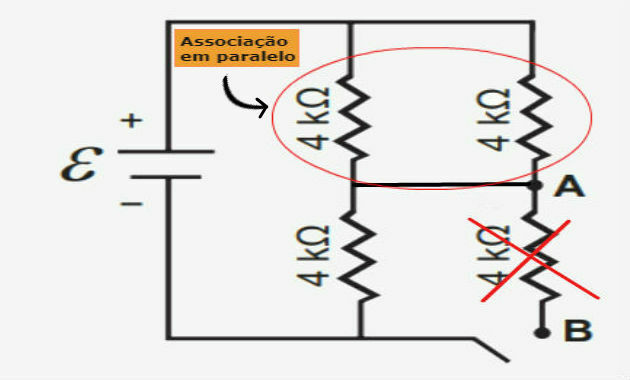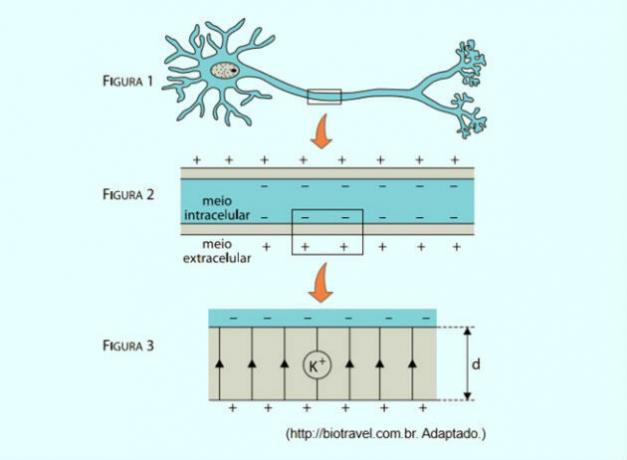Cell organelles are similar to small organs existing inside cells. In the cytoplasm of eukaryotic cells, there are small structures that have specific functions.
It is these organelles that will ensure the effective functioning of each cell in an organism.
1) Membranous organelle present in hepatocytes related to several functions, including the one intended for the degradation of toxic substances (ethyl alcohol, for example), it is deactivated through enzymatic action.
Which option below best fits the description above?
Lysosome
Mitochondria
Peroxisome
Golgi complex
Core
Right answer - Letter C.
The peroxisome is present mainly in the liver. Liver cells are known as hepatocytes. The liver has the task of metabolizing all ingested substances in order to detoxify the body.
Inside this organelle, chemical reactions mediated by enzymes take place using oxygen and hydrogen to form hydrogen peroxide (H2O2).
2) _________ is responsible for the abundant synthesis of ATP in the presence of oxygen.
mitochondria
granular endoplasmic reticulum
ribosome
peroxisome
centriole
Right answer - Letter a.
Mitochondria perform cellular respiration. Therefore, it uses oxygen to produce Adenosine Triphosphate (ATP) in large quantities.
3) Organelle capable of absorbing light energy through specific pigments. The folding of the internal membrane originates sheets that dive into the stroma, forming the thylakoids and thylakoids. money.
The text description refers to the organelle:
Chlorophyll
Mitochondria
Peroxisome
Glycoxisome
Chloroplast
Right answer - Letter e.
Chloroplast is the organelle responsible for carrying out photosynthesis in plants. Chlorophyll is one of the pigments present in the chloroplast.
4) Ribosomes are non-membranous cytoplasmic organelles made up of protein and RNA. These organelles:
They are always found free in the cytoplasm and act in protein synthesis.
They are always attached to the external wall of the endoplasmic reticulum and act in the synthesis of lipids.
they can be found free in the cytosol or adhered to the external wall of the endoplasmic reticulum, and act in protein synthesis.
They always adhere to the outer wall of the endoplasmic reticulum and synthesize proteins.
They only form sets known as polyribosomes, responsible for protein synthesis, and are never attached to the external face of the endoplasmic reticulum.
Right answer - Letter C.
Ribosomes can be found free, in eukaryotic and prokaryotic cells, or attached to the external face of the endoplasmic reticulum, in eukaryotic cells. Its function is to produce proteins for the body.
5) Aerobic cellular respiration, photosynthesis, protein synthesis and intracellular digestion of phagocytosed particles are functions related, in order, to the following organelles:
chloroplast, mitochondria, peroxisome and ribosomes
mitochondria, chloroplast, lysosome and ribosome
granular endoplasmic reticulum, chloroplast, ribosome and glyoxysome
mitochondria, chloroplast, ribosome and lysosome
glyoxysome, chloroplast, lysosome and agranular endoplasmic reticulum
Right answer - Letter C.
Mitochondria perform aerobic cellular respiration, that is, they use oxygen to produce ATP.
The chloroplast uses light energy to produce glucose, that is, it performs photosynthesis.
The ribosome is responsible for producing proteins for the body.
And, finally, the lysosome performs the intracellular digestion of particles ingested (phagocytosis) by the cell.
6) Centrioles, flagella and cilia are responsible for the following cellular functions:
cell division, removal of impurities and phagocytosis.
cell locomotion, cell division and exocytosis.
protein synthesis, cell division and cleaning of impurities.
phagocytosis, exocytosis and cleaning of impurities.
cell division, cell locomotion and cleaning of impurities.
Right answer - Letter e.
The centriole participates in the processes of cell division, mitosis and meiosis. Flagella are filaments that allow the movement of a cell, such as the tail of sperm. Cilia, on the other hand, help in the self-cleaning of cells, removing the impurities present.
7) Note the items:
I - Storage and secretion of proteins.
II – Production of mucus.
III - Protein synthesis
IV – Formation of the sperm acrosome.
V - Release of vesicles containing enzymes.
The Golgi system is a set of flat, stacked sacculations called dictyosomes. Of the items above, the option that is not related to the function of this organelle is:
III
I
II
IV
Right answer - Letter C.
The organelle responsible for protein synthesis (protein production) is the ribosome and the granular (rough) endoplasmic reticulum, as the latter has ribosomes.
The golgi complex only stores, packages, modifies the molecular shape and sends out the proteins received by the granular endoplasmic reticulum.
8) Some organelles have their own genetic material, ribosomes and other structures that allow them to live partially autonomously.
Select the option that contains these organules.
granular endoplasmic reticulum and golgi complex
mitochondria and peroxisomes
lysosomes and centrioles
vacuoles and chloroplasts
mitochondria and chloroplasts
Right answer - Letter e.
According to endosymbiosis theory, Mitochondria and chloroplasts were free-living prokaryotic organisms, which, when phagocytosed by a eukaryote, formed a kind of mutualism. This allowed life to develop more absolutely.
Therefore, these are the only organelles that have their own genetic material.
9) Microfilaments (actin, tubulin, keratin, etc.) are structures related to various functions, such as, for example, a scaffold designed to support other cell structures.
The text description refers to:
agranular endoplasmic reticulum
Golgi apparatus
DNA
cytoskeleton
cytoplasmic membrane
Right answer - Letter D.
The cytoskeleton is a structural network that supports a cell. In addition to providing stability and support, it is extremely important in the cell division processes in animal cells.
10) In plants, membranous organelles called plastids are found. There are three basic types: chloroplasts, amyloplasts and chromoplasts, each containing predominant substances.
Select the option that contains the chemical substances in the order in which the plastids are presented.
chlorophyll, starch, carotenoids
chlorophyll a, chlorophyll, b and amylopectin
chlorophyll a, amylose and chromopectin
chlorophyll f, amylose, carotene
chlorine, starch, chromene
Right answer - Letter a.
The pigments and other substances produced/stored by plastids are:
* Chlorophyll: Present in chloroplasts, responsible for transforming electromagnetic energy (light) into biological energy (glucose);
* Starch: Storage of glucose produced in photosynthesis in starch granules, called amyloplast;
* Carotenoids: In addition to chlorophylls The It is B, green pigments by physical-chemical nature, there are carotenoids. Carotenoids allow the capture of frequencies of electromagnetic waves that are below that of chlorophylls. They are generally orange or yellow pigments.
11) Normally, there is interaction between the granular endoplasmic reticulum, the Golgi apparatus and lysosomes, and it is clear that the latter organelle contains:
enzymes that act in the extracellular digestion of bacteria that invade the body.
enzymes that act in the internal digestion of particles phagocytosed by the cell or cellular materials that are discarded.
enzymes that are stored in the Golgi system for later destruction of this organelle.
lipids that are used in the process of releasing energy for the functioning of the granular endoplasmic reticulum
carbohydrates that will be converted into mucus inside dictyosomes of the Golgi system.
Right answer - Letter B.
Inside the lysosomes there is a material full of digestive enzymes.
These enzymes serve both to digest food particles that are phagocytosed by the cell, and for processes of elimination of a cellular component or, when necessary, the entire cell.
12) Translucent material, rich in mineral salts, water and other substances. In it, the organoids perform their biological functions, dragged by a current oriented in a certain direction known as cyclosis.
What cellular structure does the text refer to?
agranular endoplasmic reticulum
cytoplasmic membrane
cytoskeleton
nucleoplasm
cytosol
Right answer - Letter e.
The cytosol, also known as cytosol, hyaloplasm or cytoplasm, is rich in water, mineral salts and other substances. All the organelles are immersed in it, in an analogy, it would be all the water in a swimming pool.
13) In plants, leaf and seed cells have special structures normally associated with fixation carbon dioxide (leaves) and the transformation of fatty acids into smaller substances (seeds).
What structure does the text refer to?
endoplasmic reticulum
core
vacuole
glyoxysome
nucleolus
Right answer - Letter D.
Glyoxysomes are actually special peroxisomes.
Because they have ultraspecific functions in daughters and seeds, they are called glyoxysomes.
14) This organelle is characterized by the storage of non-pigmented substances, but which are extremely important for the nutritional, storage and growth processes of plants.
The text concerns
Leukoplasts
Chloroplast
Chromoplasts
Phenoplasts
Plasmids
Right answer - Letter a.
Leucoplast means Leuco = white / plasto = formed, that is, a structure made up of colorless or white substances such as, for example, starch.
15) It has selective permeability, composed of a phospholipid bilayer and acts as a envelope for all cellular components.
Select the option that contains the structure and its chemical nature.
carioteca / polar
plasma membrane/nonpolar
plasma/amphipathic membrane
plasma membrane/nonpolar
lipid double layer/cell wall
Right answer - Letter C.
The plasma or cytoplasmic membrane is responsible for limiting the entry of particles into the cell, therefore, it has selective permeability.
In addition to having a polar head (phosphates) and a lipid tail (nonpolar), it is therefore chemical in nature amphipathic.
Bibliographic references
UZUNIAN, A.; BIRNER, E. Biology: single volume. 3rd ed. São Paulo: Harbra, 2008.
CASTILHO, Rubens. 15 exercises on organelles to fix the subject.All Matter, [n.d.]. Available in: https://www.todamateria.com.br/exercicios-sobre-organelas/. Access at:
See too
- 10 exercises on cytology (cells) with comments
- Exercises on plasma membrane
- Cellular Organelles
- Exercises on mitosis and meiosis
- Cytology
- 10 Exercises on photosynthesis to understand the subject
- Endoplasmic reticulum: smooth and rough and their functions
- Prokaryotic and eukaryotic cells



